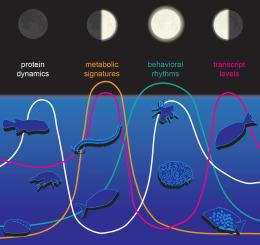Journal of Molecular Biology ( IF 5.6 ) Pub Date : 2020-03-19 , DOI: 10.1016/j.jmb.2020.03.009 Gabriele Andreatta 1 , Kristin Tessmar-Raible 1

|
Starting with the beginning of the last century, a multitude of scientific studies has documented that the lunar cycle times behaviors and physiology in many organisms. It is plausible that even the first life forms adapted to the different rhythms controlled by the moon. Consistently, many marine species exhibit lunar rhythms, and also the number of documented “lunar-rhythmic” terrestrial species is increasing. Organisms follow diverse lunar geophysical/astronomical rhythms, which differ significantly in terms of period length: from hours (circalunidian and circatidal rhythms) to days (circasemilunar and circalunar cycles). Evidence for internal circatital and circalunar oscillators exists for a range of species based on past behavioral studies, but those species with well-documented behaviorally free-running lunar rhythms are not typically used for molecular studies. Thus, the underlying molecular mechanisms are largely obscure: the dark side of the moon.
Here we review findings that start to connect molecular pathways with moon-controlled physiology and behaviors. The present data indicate connections between metabolic/endocrine pathways and moon-controlled rhythms, as well as interactions between circadian and circatidal/circalunar rhythms. Moreover, recent high-throughput analyses provide useful leads toward pathways, as well as molecular markers. However, for each interpretation, it is important to carefully consider the, partly substantially differing, conditions used in each experimental paradigm. In the future, it will be important to use lab experiments to delineate the specific mechanisms of the different solar- and lunar-controlled rhythms, but to also start integrating them together, as life has evolved equally long under rhythms of both sun and moon.
中文翻译:

月球的阴暗面:月球节律和时钟的分子机制。
从上世纪初开始,大量科学研究证明,月球周期决定着许多生物的行为和生理。可能甚至第一生命的形式也适应了月亮控制的不同节奏。一致地,许多海洋物种表现出月球节律,并且记载的“有节奏的”陆生物种的数量也在增加。生物遵循不同的月球地球物理/天文节律,其周期长度差异显着:从数小时(昼夜节律和昼夜节律)到几天(环月轮和周轮周期)。根据过去的行为研究,许多物种都有内部圆形和圆形振荡器的证据,但是那些行为自如的月球节奏有据可查的物种通常不用于分子研究。因此,潜在的分子机制在很大程度上是模糊的:月亮的阴暗面。
在这里,我们回顾了一些发现,这些发现开始将分子途径与月球控制的生理和行为联系起来。目前的数据表明代谢/内分泌途径与月球控制节律之间的联系,以及昼夜节律和昼夜节律/昼夜节律之间的相互作用。此外,最近的高通量分析为途径以及分子标记提供了有用的线索。但是,对于每种解释,重要的是要仔细考虑每种实验范式中使用的部分实质上不同的条件。将来,重要的是要使用实验室实验来描述不同的太阳和月球控制节奏的具体机制,但也要开始将它们整合在一起,因为在日月节奏下生活已经相当长地发展了。



























 京公网安备 11010802027423号
京公网安备 11010802027423号